At Bedrock Gardens art leads you on a journey
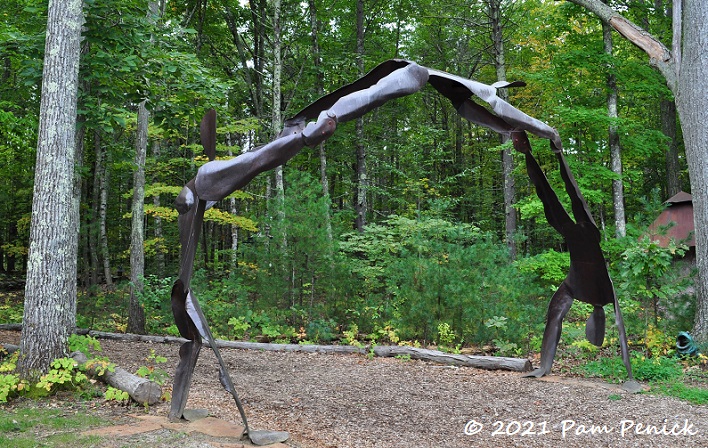
In early October, as we road-tripped south from our leaf-peeping week in New Hampshire’s White Mountains, I was head-over-heels excited to revisit Bedrock Gardens, a private-transitioning-to-public garden in the town of Lee.
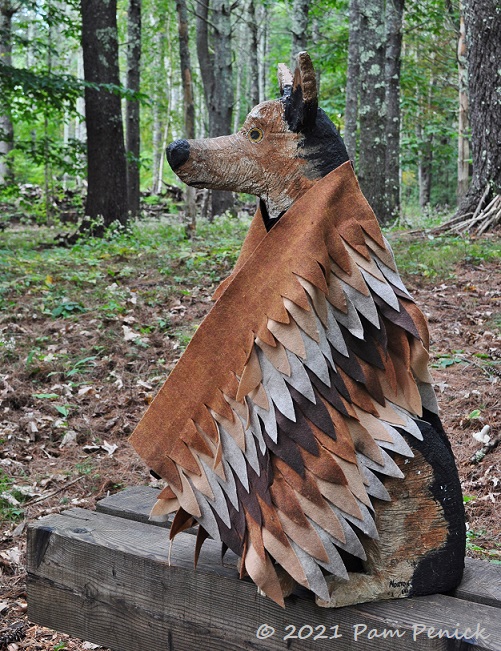
I first visited Bedrock Gardens in 2014, when the owners, Jill Nooney and Bob Munger, were still managing their 30-year-old garden on 20 acres of farmland on their own, with seasonal help from volunteers. Seven years later, they’ve transitioned their home garden into an emerging public garden with regular visiting hours, a parking lot, entry kiosk, restrooms, and gift shop. Jill and Bob still reside on-site and have private space by their house, but by going public they hope to preserve their remarkable garden for future generations to enjoy. What a gift to the community and their state.
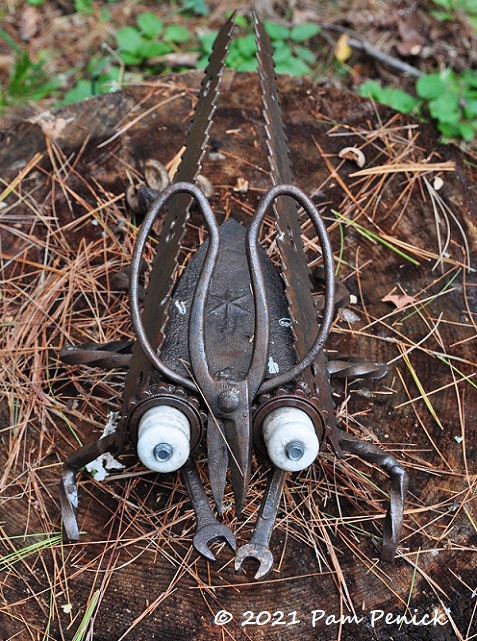
What I love about Bedrock is that it’s a journey garden, one that evokes humor and magic thanks to Jill’s found-object art (much of it made with old farm implements) and Bob’s handcrafted structures interspersed among creative and mature plantings. The various garden spaces convey moods of serenity, excitement, and mystery. Sight lines on an epic scale draw the eye through the garden, and pull you along to experience each space. Exploring the garden is a voyage of discovery and delight.
Gothic Arbor
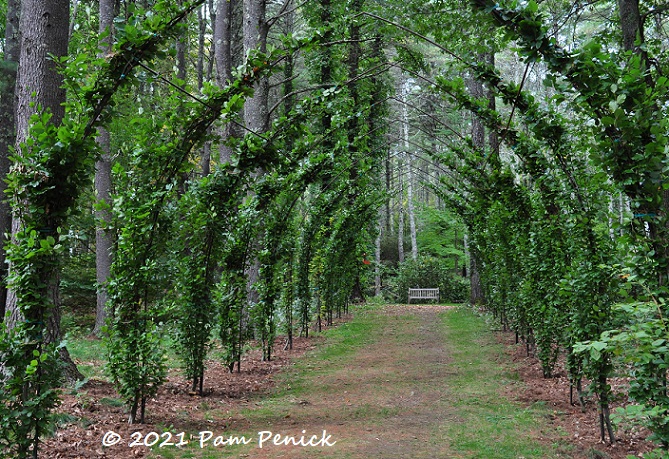
The garden’s entrance has changed since I last visited, moved away from the house. You enter the garden nowadays under an acrobat arch (see top photo), which leads into a towering wood meant to “cleanse your spirit as you leave the world behind.” A Gothic arbor, planted with golden fastigiate beeches, frames a view of a bench in one direction, and in the other leads to a pond.
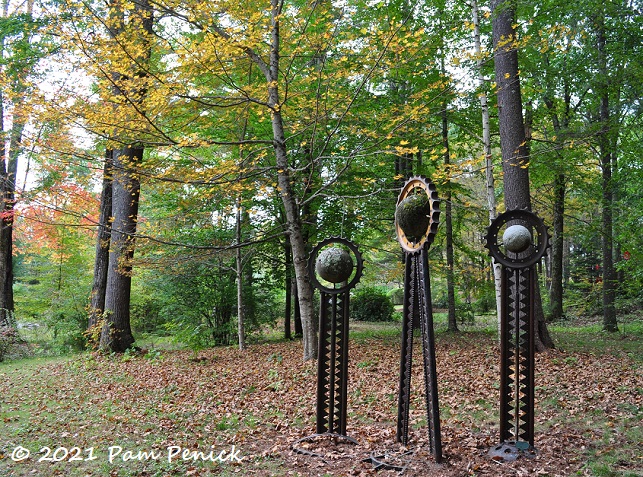
Jill favors vertical sculptures or totems in the garden, some out in the open, like these, and others tucked among plants. I think of these as sun totems.
Tea house
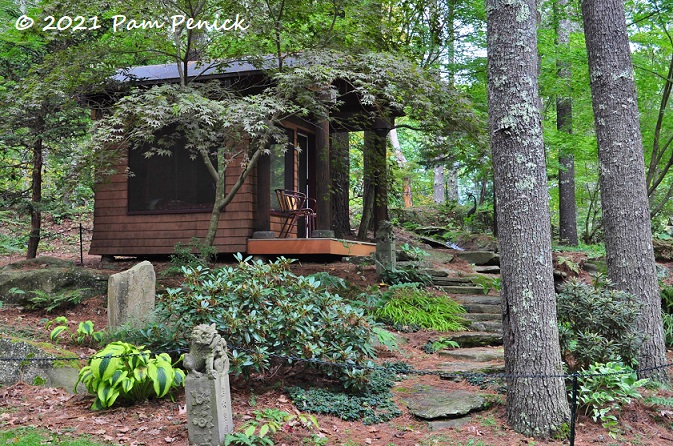
The map shows a designated route through the garden, but there was a guided tour ahead that I wanted to avoid as I took photos, so I ended up walking it in reverse. I do wonder how the garden unfolds in the other direction though, so if I ever return I’ll go that way. Next we came to a tea house in the woods, which was chained off, tastefully, to prevent a closer approach.
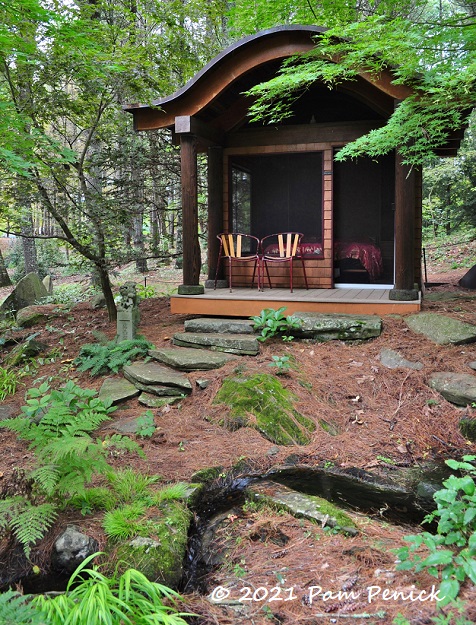
Jill once told me that she and Bob sometimes enjoy sleeping out here, and it looks like the bed is still inside, so perhaps this private space is reserved for the owners’ sole enjoyment.
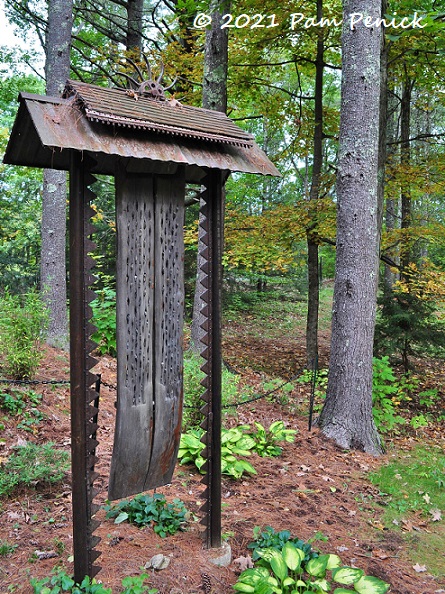
A found-object sculpture nearby has an Asian-inspired roof. I’m curious to know what the toothed rails and perforated middle section come from.
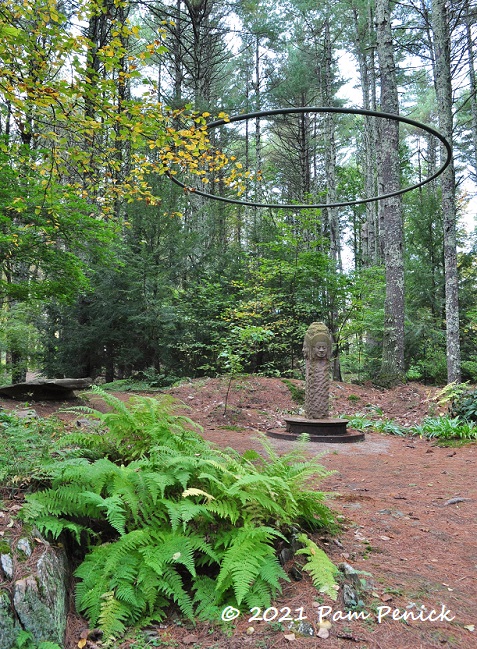
An uphill path leads to a sculpted Buddha pillar under a large halo suspended from the trees, seeming to float overhead. The energy of that halo makes for a striking scene.
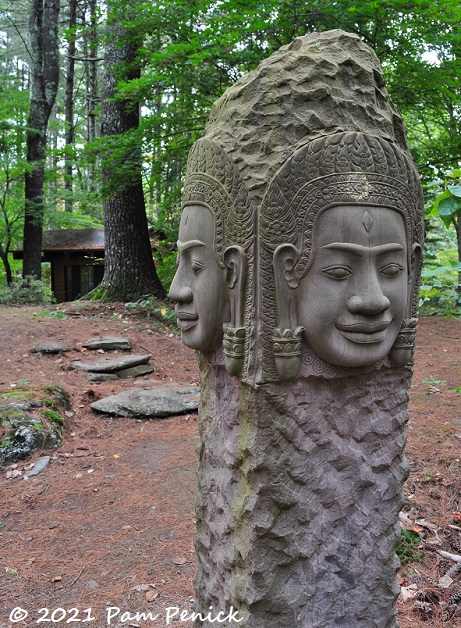
ConeTown
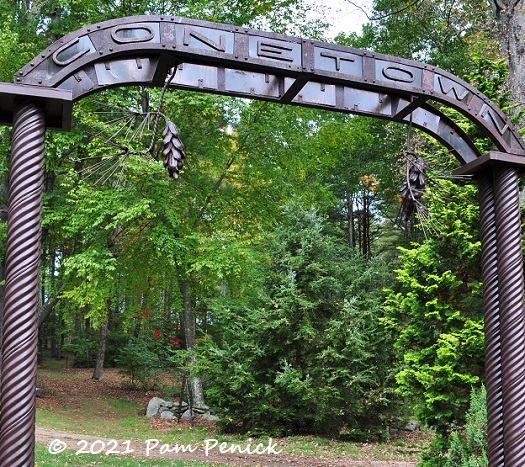
Emerging from the woods, you come to Conetown, marked by a wide steel arch adorned with dangling metal cones.
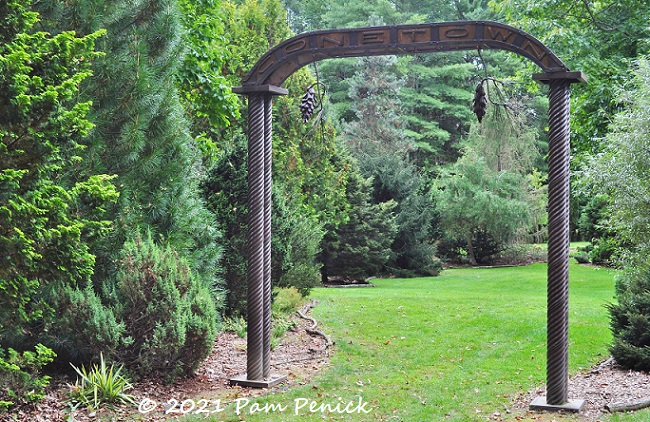
This pinetum contains a collection of 70 dwarf and standard conifers! That’s what you can do when you have 20 acres to play with.
CopTop
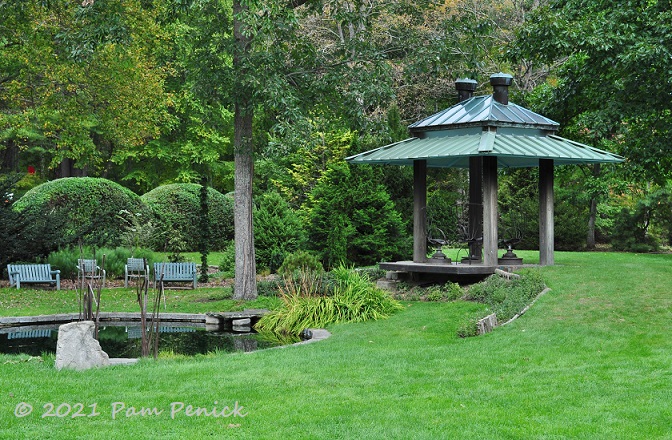
Just as the garden becomes sunny and open, a gazebo appears. Capped with antique skylights and sheltering a few chairs made from old farm tools, it offers a spot to sit and enjoy a small pond.
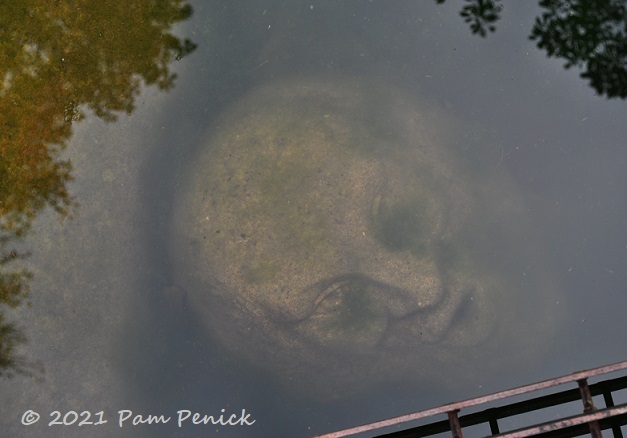
Someone else is here too, waiting in the water to surprise you.
Wiggle Waggle
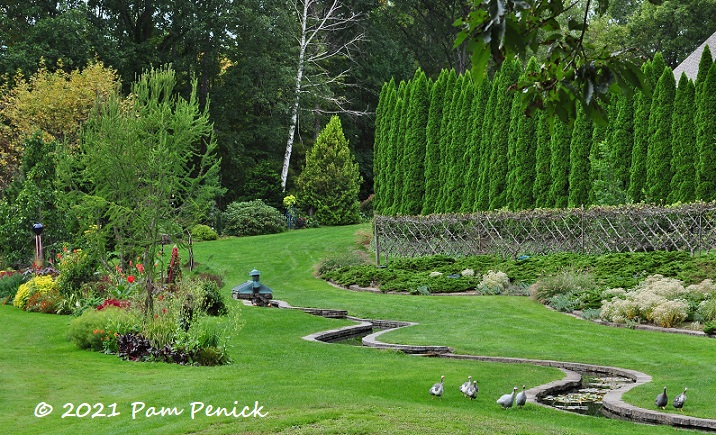
Undulating between the pond and a spring house, a 200-foot rill called the Wiggle Waggle introduces a sense of playfulness and frivolity. The colorful Garish Garden stretches along one side, and a Belgian fence of espaliered apple trees, backed by a tall screen of arborvitae, runs along the other. Unexpectedly, a flock of speckled guinea hens appeared, darting across the Waggle toward us.
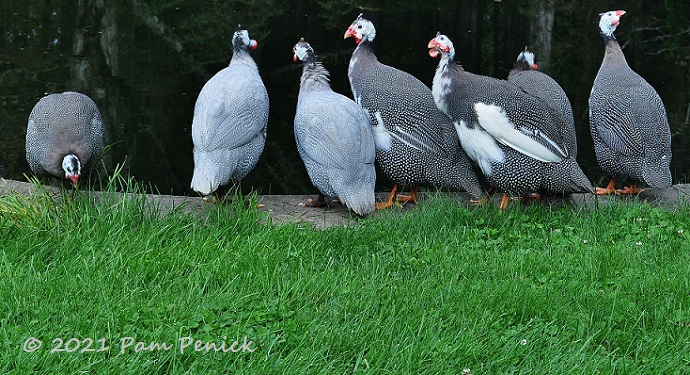
Unperturbed by our approach, they gathered to drink from the rill, chattering at each other. I saw Bob tending to some plants nearby and struck up a conversation. We’d never met in person, although I’d interviewed Jill for an article in Garden Design once. Bob told me the guinea fowl are beloved pets who roam the garden during the day. Later I read on the garden’s Facebook page that all but two of the birds were killed by an unknown predator, likely a fox. I know foxes have to eat too, but I was sorry about the guineas.
GrassAcre
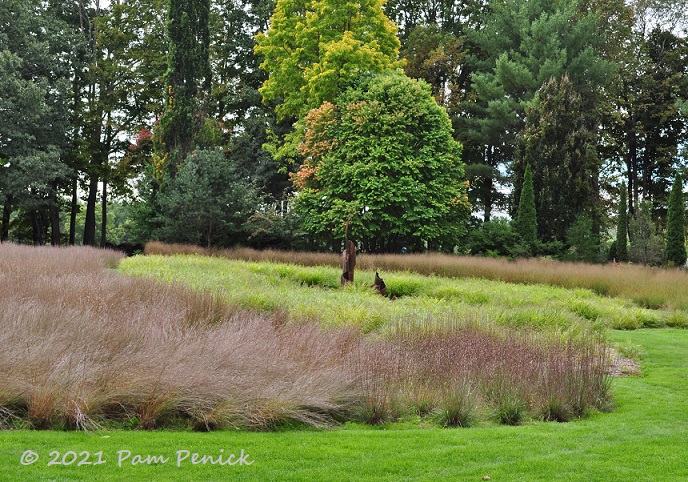
On a gentle slope nearby, masses of grasses make a stylized meadow. GrassAcre consists of red (switchgrass), green (hakone grass), and blue (little bluestem) grasses, massed for a painterly effect as seen from a distance.
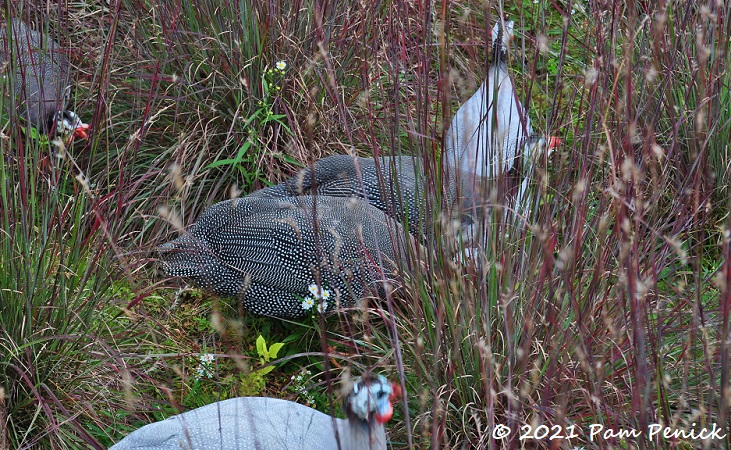
The guineas followed us over.
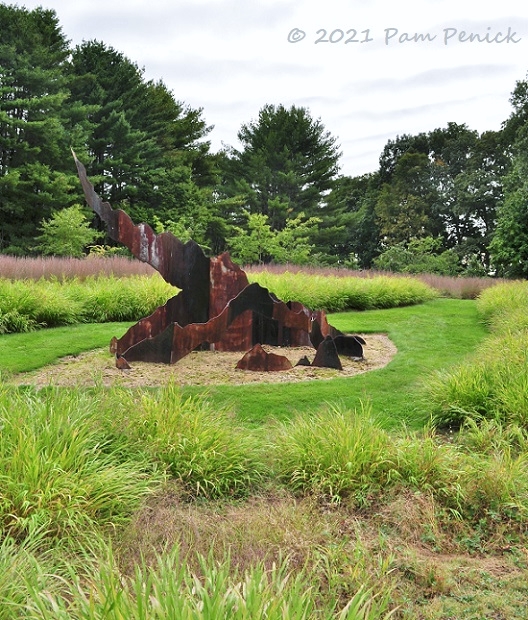
In a central plane of turf grass, a steel sculpture called SyncoPeaks evokes distant mountains.
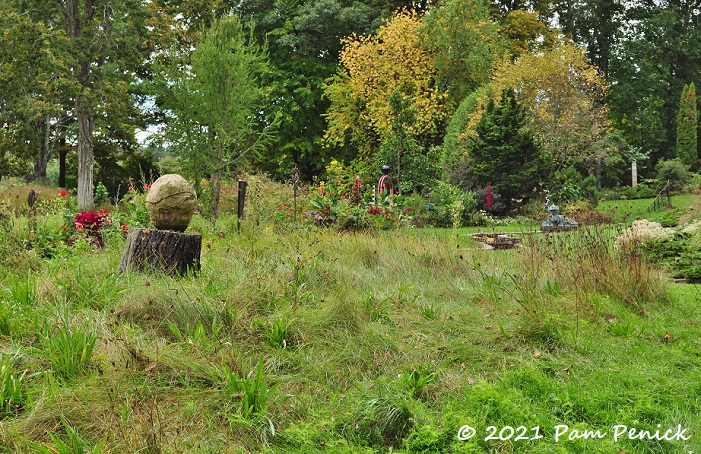
Nearby, a naturalistic meadow surrounds a tree stump elevating a spherical artwork.
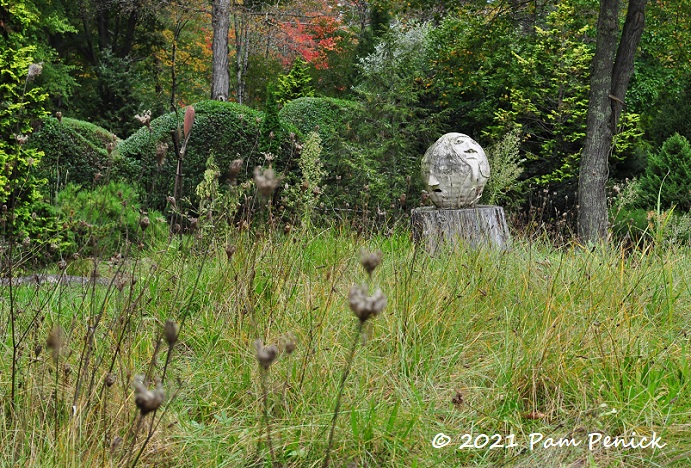
I like this piece as a focal point, and it echoes the round-topped undulating hedge of the Pate behind it.
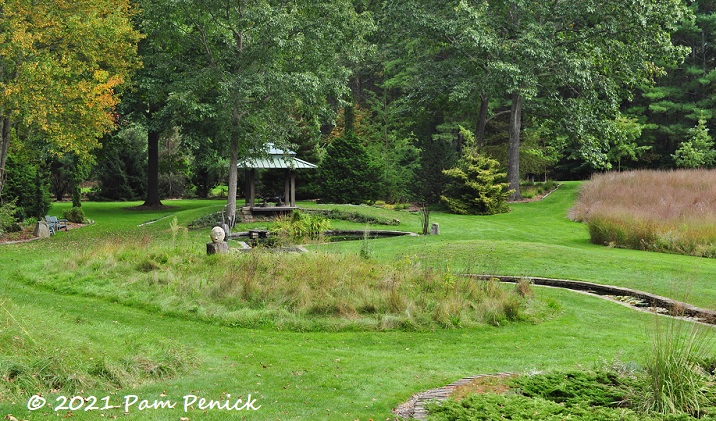
A wider view, with the pond and CopTop gazebo.
The Pate
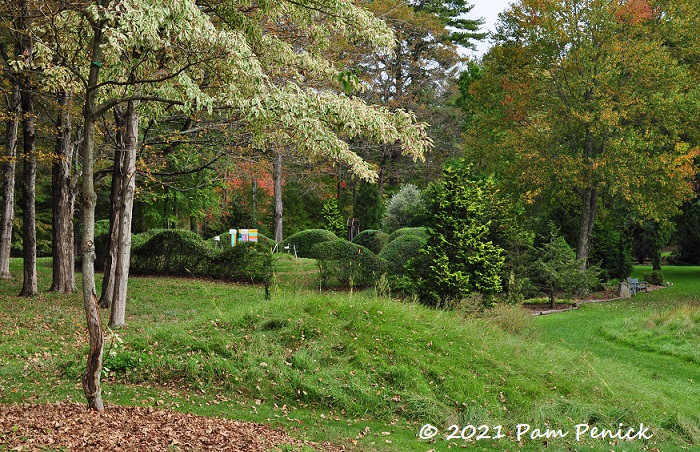
A wavy hedge of clipped privet known as the Pate has a gap that invites you in.
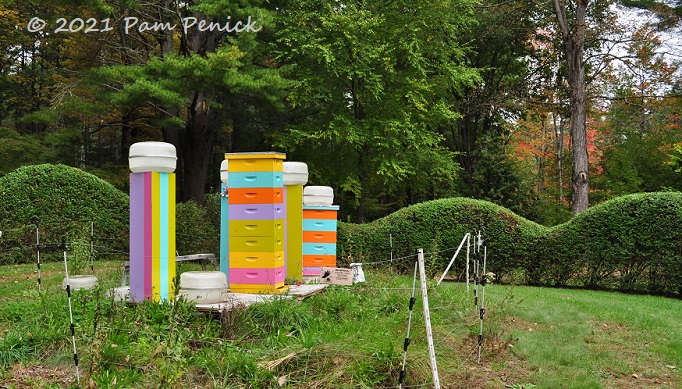
In the center stand colorfully striped beehives.
Rock Garden and the Landing
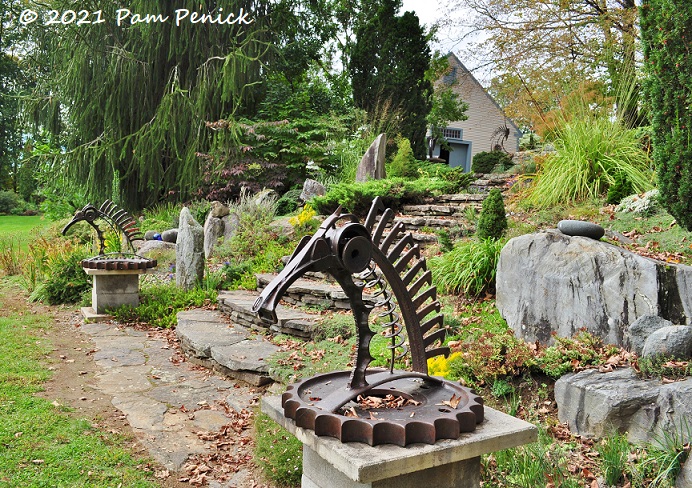
Back by the rill, a pair of horse-head sculptures frame a broad stone stair leading through a boulder-edged garden. A large barn stands at the top of the hill, and Jill and Bob’s house sits beyond that.
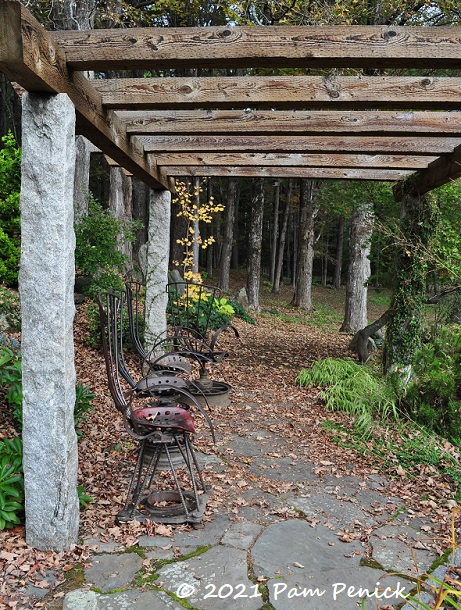
Along the ridge, a pergola supported by granite pillars offers an elevated view of GrassAcre and the surrounding garden.
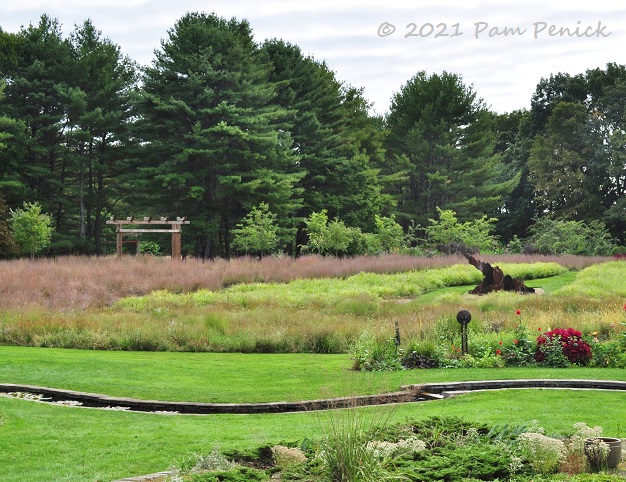
Jill and Bob are gardening on a scale well beyond what most of us can imagine. I admire the way they create big moments like this as well as intimate garden rooms, plus vignettes of art and plants along paths connecting everything.
Belgian fence
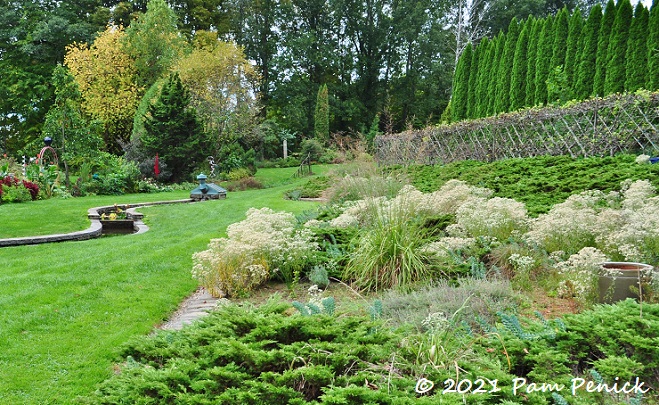
A long view of the Belgian fence, with grasses and junipers carpeting a broad slope.
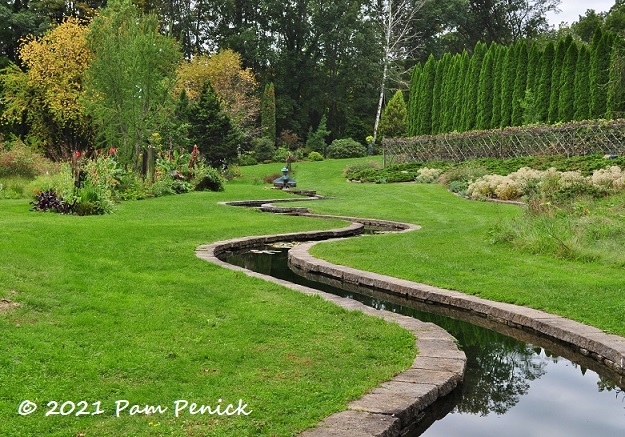
And the Wiggle Waggle making its snaky passage through the lawn. I’ve seen photos of this in the winter, with the serpentine line of the water cutting through mounds of white snow.
The Wave and arborvitae hedge
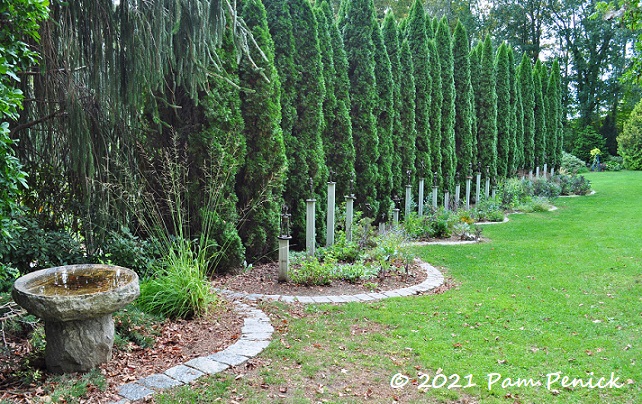
What’s on the other side of the arborvitae hedge, you might wonder? Actually, another big moment: the Wave, a chorus line of 26 of Jill’s metal folk displayed on undulating painted posts.
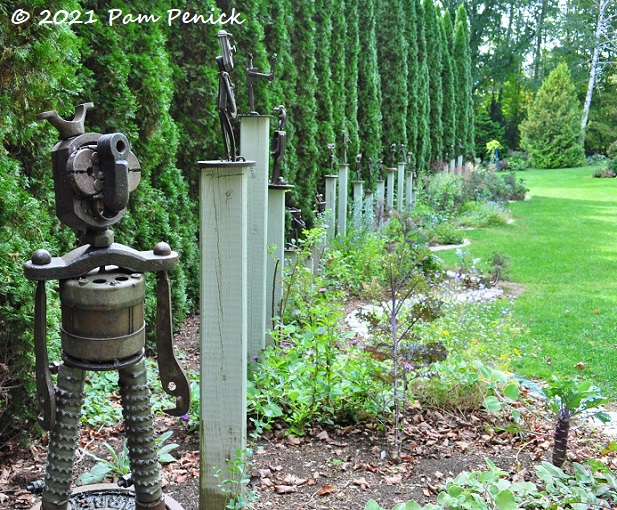
Jill gave each of her quirky creatures personality and charm.
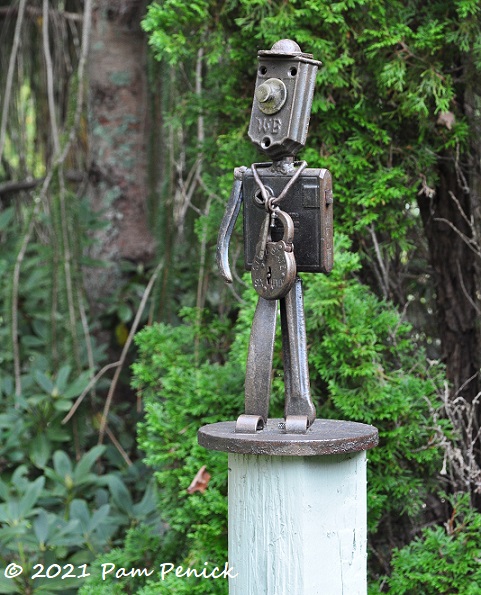
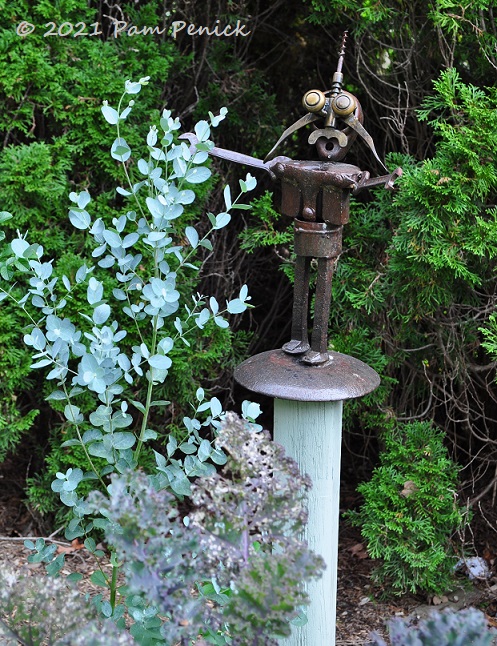
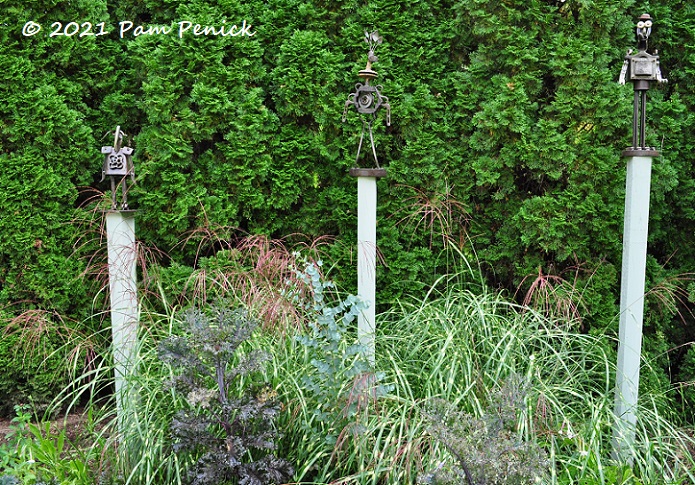
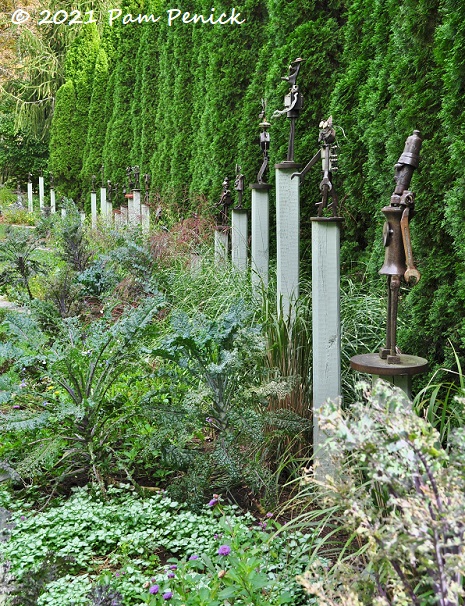
The wave effect of the posts is nicely framed by the dark arborvitae screen.
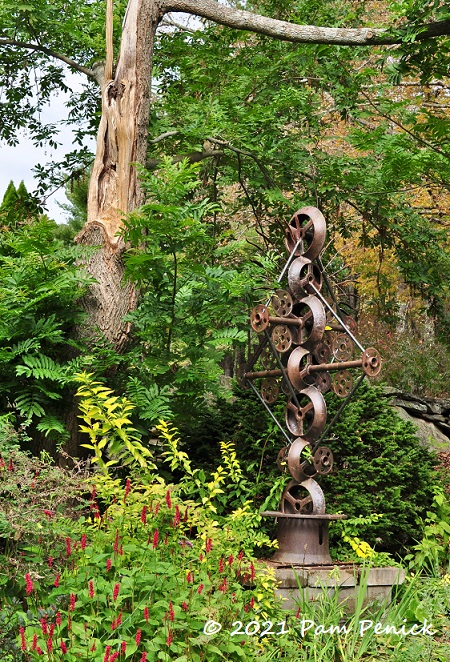
One more totemic sculpture up by the barn.
Barn Garden
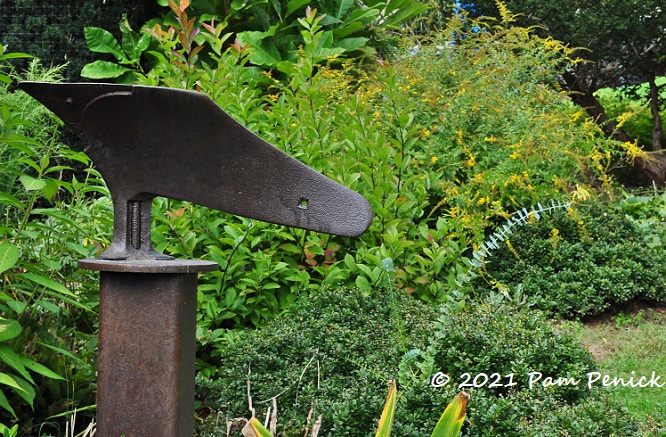
I adore this found-object bird sculpture in the Barn Garden. There are many of Jill’s sculptures I covet, but this is one of my favorites.
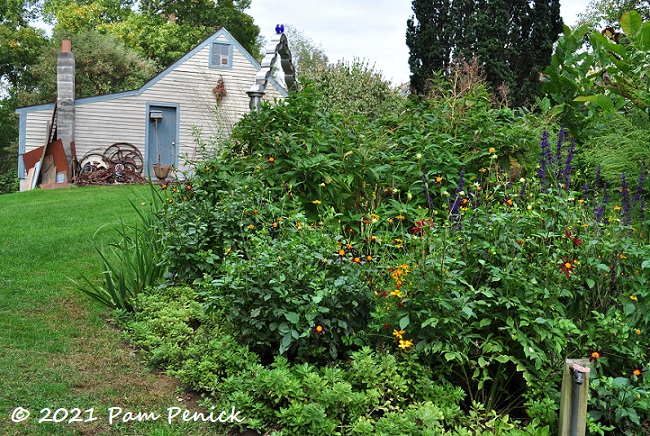
A tumble of flowering perennials jostle for sunlight here.
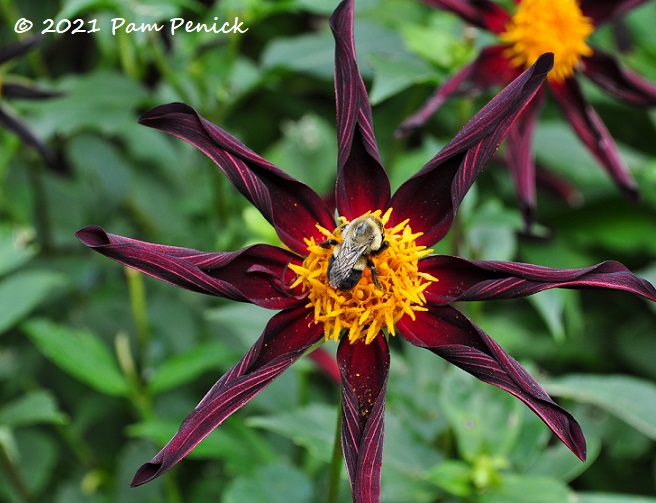
Bees were enjoying the bounty.
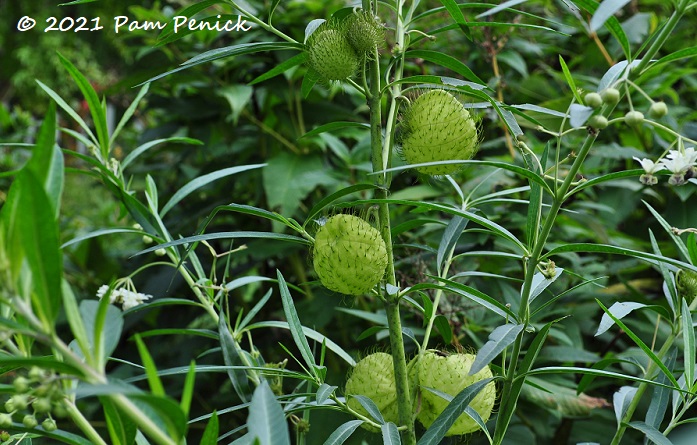
Hairy balls (Gomphocarpus physocarpus) always makes me smile.
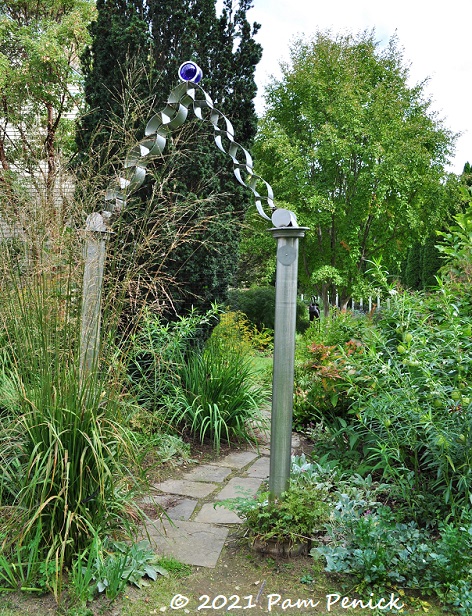
A creative peaked arbor leads into the garden.
Parterre Garden
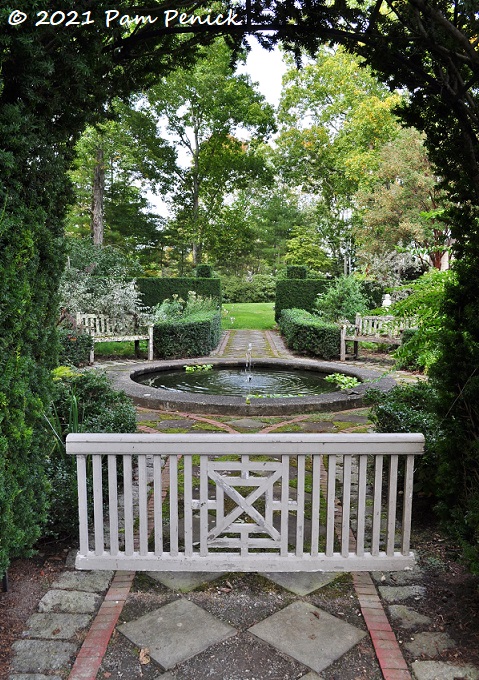
Contrasting with the cottagey barn garden, a formal parterre garden leads to private space by the owners’ house. A section of porch railing on the path barred the way in, so we stood under the yew arch and just looked.
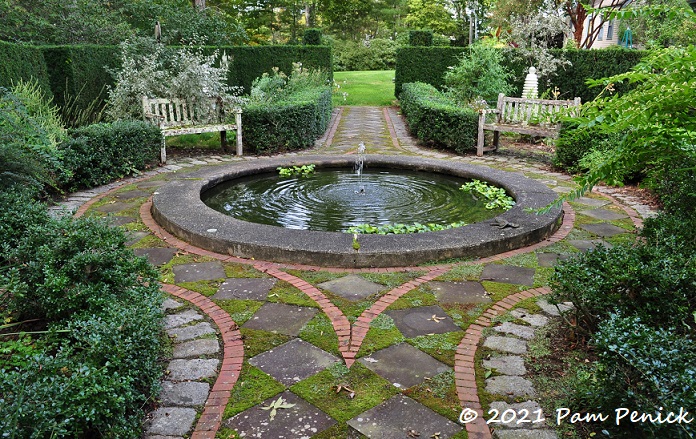
It’s an elegant space, given a little harlequin twist with a diamond pattern of gray pavers amid squares of green and swooping red-brick edging.
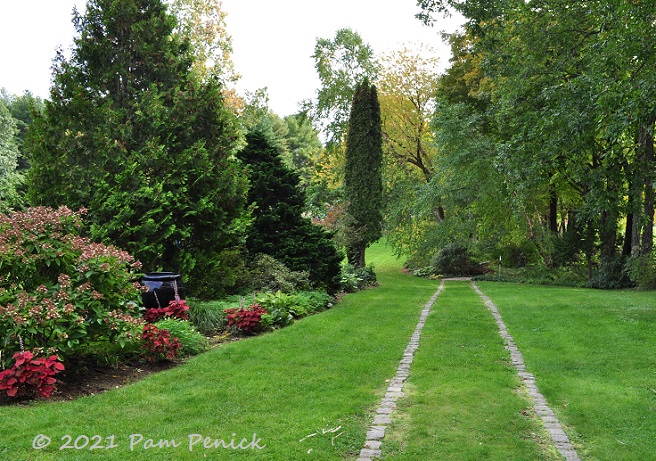
Turning around, you see a double line of stone paving leading the eye to the Swaleway woodland.
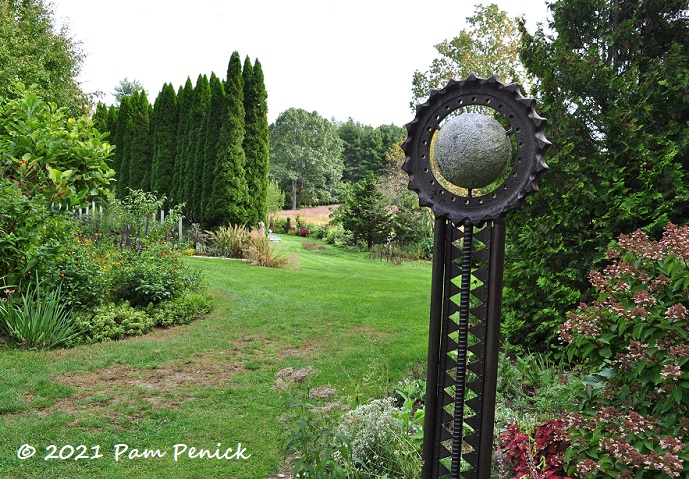
We headed that way, stopping to admire another sun totem…
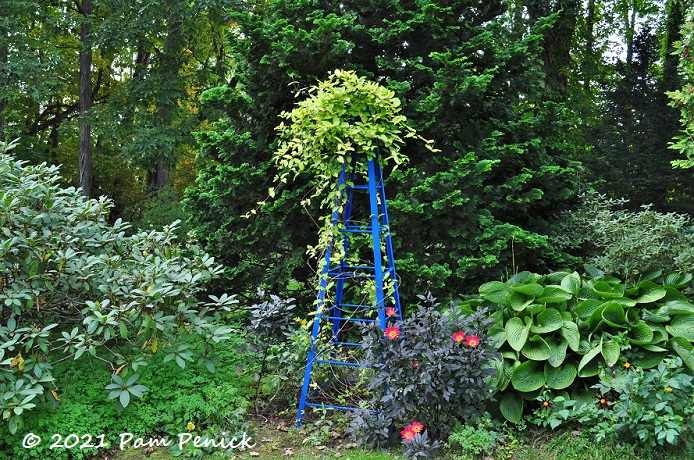
…and blue steel tuteur smothered by a vine perched on top like a Daniel Boone coonskin cap.
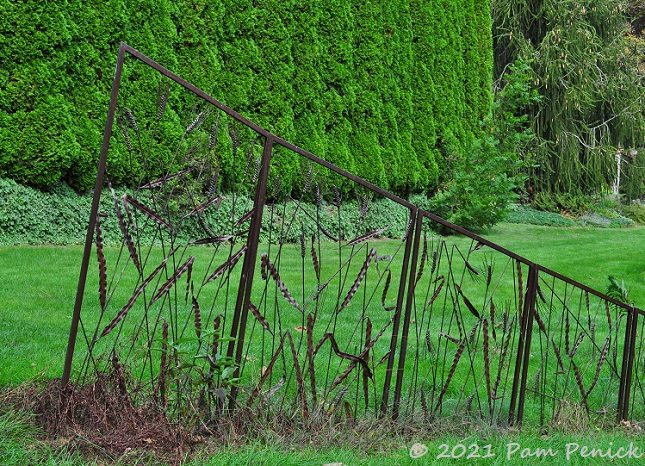
A tilted screen of metal reeds leads the eye to the spring house and Wiggle Waggle.
Funnel Gardens
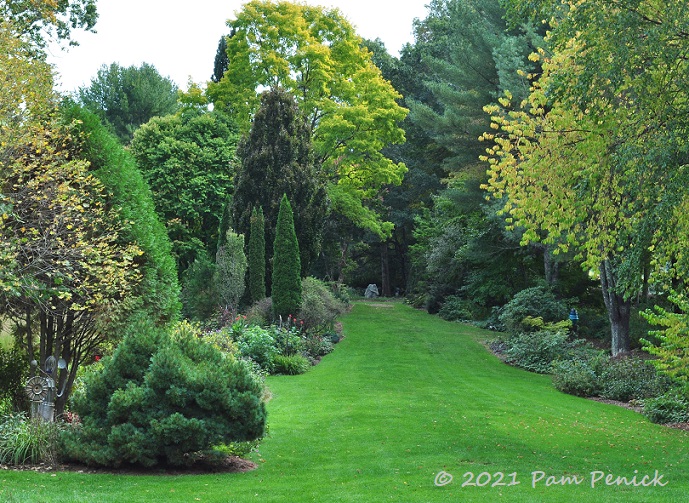
And here a stunning view unfolds, with trees in hues of emerald, yellow-green, and wine-red lining both sides of a long lawn. Shapes are contrasted too, from vertical spires to rounded canopies. The Funnel Gardens really do funnel the eye to a distant upright boulder, the terminus of this long axis. This is one of the most beautiful views in the garden.
Swaleway
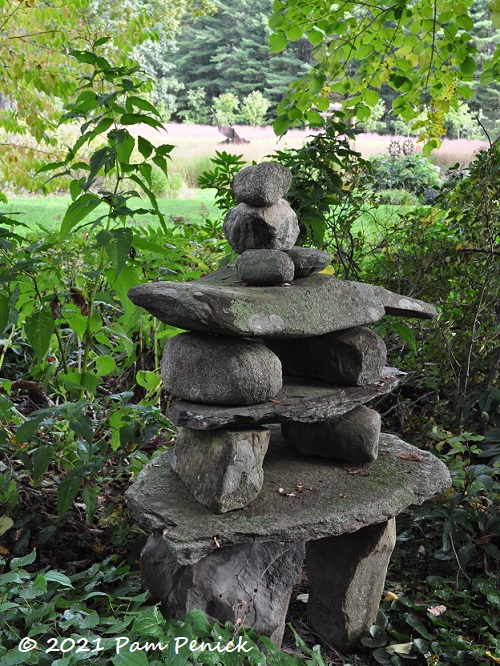
Stepping into the woods bordering the lawn, you’re in the Swaleway, where spring-flowering plants “brighten the mud season,” according to the brochure. Stacked rock towers allude to wayfinding cairns on top of New Hampshire’s Mount Washington.
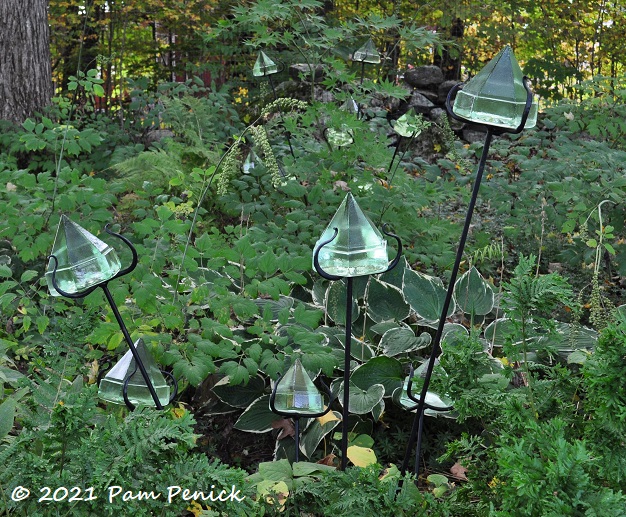
Colored glass prisms — deck prisms once used on sailing ships — set on stakes make glassy bouquets that bring light into the shady garden.
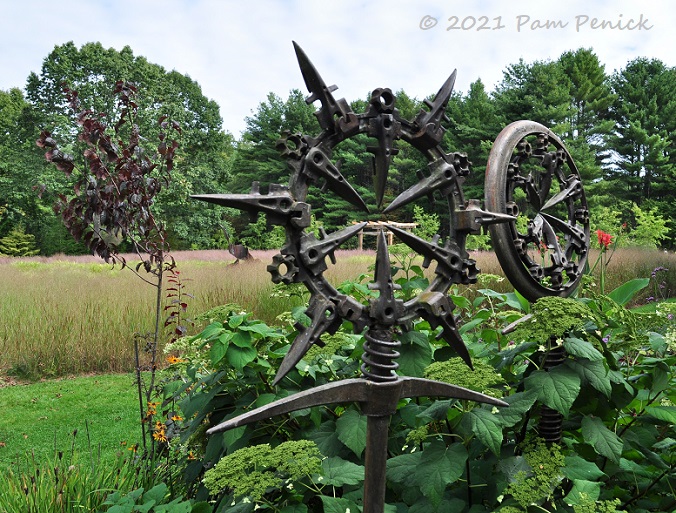
On the sunny side of the Funnel Gardens, one dagger-like sculpture frames a view of a distant arbor called the Torii…
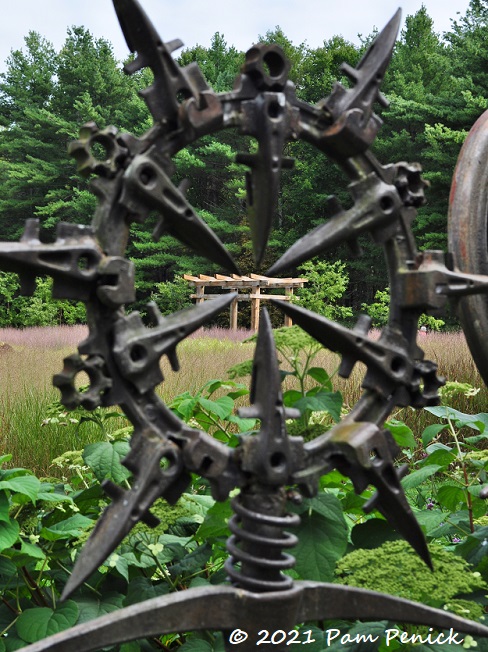
…if you position yourself just so.
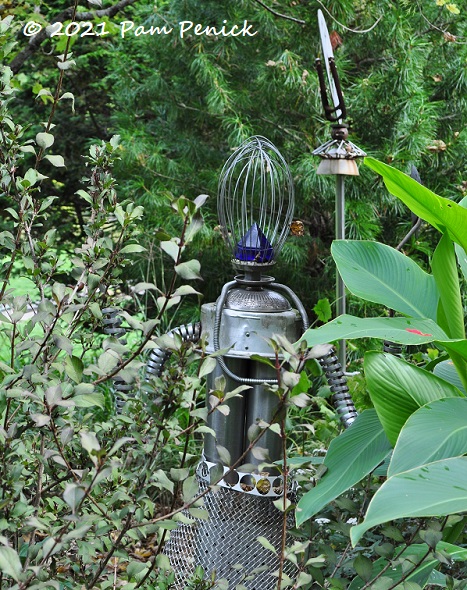
A whisk-headed, robotic Julia Child makes me wonder if butter-colored flowers surround her in summer.
Torii at GrassAcre
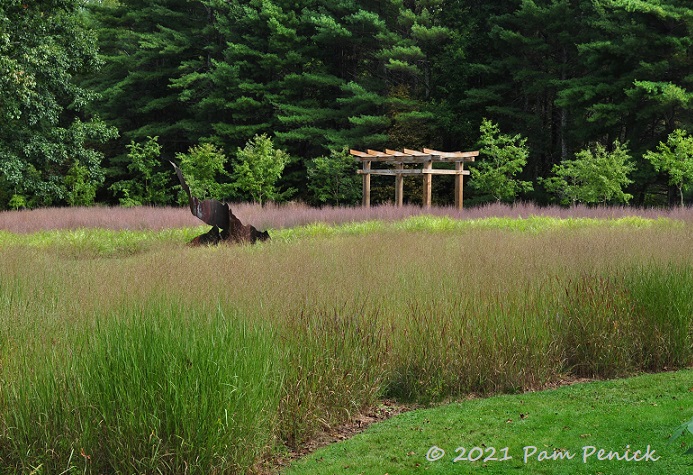
Beyond GrassAcre, the Torii beckons.
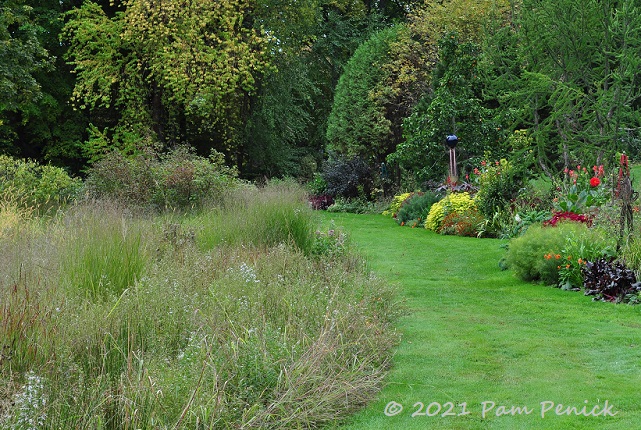
But first we must explore the exuburant Garish Garden, coming up in part 2.
Up next: Part 2 of my visit to art-infused Bedrock Gardens. For a look back at colorful fall foliage in the White Mountains of NH, click here.
__________________________
Digging Deeper
Need design help with your yard? Hire me as your personal garden coach! Maybe you need replacement plant ideas after the big freeze. Or maybe your landscaping has grown tired, and you want fresh curb appeal. Or perhaps you’re ready to get rid of some lawn and create a pollinator garden, bird habitat, or hangout space for you and your friends. I’m here to help! Contact me to let me know what’s going on, and let’s figure it out together. My range is Austin and suburbs within a 25-min. drive of NW Austin, but I’m flexible and can travel farther with a surcharge, so let me know where you are. Weekday morning appts. only.
Come learn about gardening and design at Garden Spark! I organize in-person talks by inspiring designers, landscape architects, authors, and gardeners a few times a year in Austin. These are limited-attendance events that sell out quickly, so join the Garden Spark email list to be notified in advance; simply click this link and ask to be added. Season 8 kicks off in fall 2024. Stay tuned for more info!
All material © 2025 by Pam Penick for Digging. Unauthorized reproduction prohibited.


Torii – Japanese Shinto gate?
And our helmeted guineafowl a LONG way from home. Those spotted feathers are pretty, if you happen across them
Yes, and I’ll have a closer photo of the Torii in the next post. As for the guinea fowl, they remind me of my Oklahoma grandma, who kept them too. I always loved their spotted feathers and cute chicks. They’re not uncommon here, so it’s funny to be reminded that they come from Africa.
Absolutely charming. Although it’s a garden of discovery everywhere you turn, it still has a wonderful coherence and flow to it (even when explored backwards).
It really does, Kris.
This is a wonderful write-up, Pam. How in the world do you manage to get all the facts straight. You writing adds so much and the photos are some of the best. Sorry to have missed you. Thank you for for such a nicely paced piece. Jill
Thank you so much, Jill! I’m glad to know you enjoyed my write-up. Your garden was just as wonderful the second time through as it was the first. Thanks for sharing it with the world.
I adore that garden and wish I had met you there! I haven’t been in quite a while but it is truly an artistic yet plant lover’s garden!
It is, Layanee, and it would have been lovely to see you. Sorry we didn’t make it your way this time, but I feel sure I’ll be in the area again one day. 🙂
Beautifully written and presented.
Thank you!
Nancy
My pleasure, Nancy. Thanks for reading!